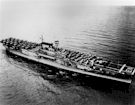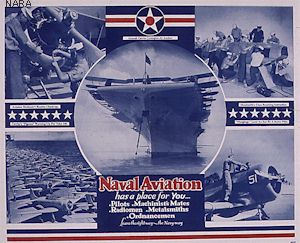
Aug 3, 1933
July 16, 1934
Oct 3, 1936
May 12, 1938
Summer 1938
Winter 1938
April 1939
History:
Prewar -
1941 -
1942 -
1943 -
1944 -
1945 -
Postwar
The Ship -
All Hands -
Decorations -
Remembrance
On a bright October Saturday in 1936, a sleek steel hull, 800 feet in length, towering over the assembled dignitaries and onlookers, slipped the ways of Newport News Shipbuilding and Dry Dock Company. The autumn air ringing with the words from Shakespeare's Othello - "May she also say with just pride: I have done the State some service" - the great ship was christened Enterprise, the seventh ship of that now-historic name to serve the United States.
Enterprise - CV-6, the Big E, the Galloping Ghost, one of the most active warships in history - was the product of a disarmament treaty.
In November 1921, the major world powers had gathered in Washington, D.C. for a conference aimed at heading off a developing naval arms race. Four months earlier, on July 21, aviation pioneer Billy Mitchell had graphically demonstrated the potential of air power, as eight biplane bombers under his command sank the former German battleship Oestfriedland before hundreds of observers. Convinced, as a result, that the U.S. Congress would never authorize the building of an expensive battleship fleet (apparently vulnerable to destruction by relatively cheap aircraft), American diplomat Charles Hughes opened the proceedings by proposing the scrapping of millions of tons of planned and building warships by all participants.
After months of negotiations, the Washington Naval Treaty emerged. The treaty imposed a naval tonnage ratio of 5:5:3:1.75:1.75 between the five signatory powers: the United States, Great Britain, Japan, France and Italy. (Roughly, for every five capital ships built by the British, the United States could build five ships, and Japan three.) It limited the maximum tonnage of any single ship to 35,000 tons, and imposed a ten year moratorium on any capital ship construction other than that needed to fill out the treaty ratio.
The treaty allowed the United States 135,000 tons for aircraft carrier construction. The first three carriers built by the United States were converted from other classes of ships. Langley CV-1 was a converted collier. Lexington CV-2 and Saratoga CV-3 were converted battlecruisers: hulls that would otherwise have been scrapped to meet treaty limits. Ranger CV-4, launched in February 1933, was the first US carrier planned as such from the start.
 Mrs. Claude A. Swanson sends Enterprise down the ways at Newport News, October 3, 1936 |
In 1931, the United States, still 55,000 tons under the carrier limit set by treaty, began planning two 19,800 ton carriers, to be designed and built using the lessons learned from the first four vessels. In the summer of 1933, pressed hard by newly elected president Franklin Roosevelt, Congress enacted a huge package of legislation - known collectively as the "New Deal" - which, amongst many other things, allotted $238 million for new naval construction, including nearly $40 million for the two new carriers.
The first of these two ships, Yorktown CV-5, was laid down on 21 May 1934, at the Newport News shipyard. Her sister ship Enterprise, was laid down just two months later, on July 16. Largely built by workers paid by the Public Works Administration - one of the many new federal programs created by the New Deal - the two ships took nearly four years each to build and fit out.
A year and a half after her launching, Enterprise was commissioned on 12 May 1938, and set course for Rio de Janeiro, Brazil, for her shakedown cruise. She returned north to Hampton Roads that winter, then sailed south again on 2 January 1939, for fleet exercises in the Caribbean with sister ship Yorktown. Stopping briefly at Saint Thomas and Guantanamo Bay, the two carriers and their air groups were exercised under the steady command of Rear Admiral William F. Halsey: an aggressive commander whose affection for Enterprise and her men would eventually become legendary.
Enterprise's commander for her shakedown cruise was Captain Newton H. White, who was relieved by Captain Charles A. Pownall on 21 December 1938. Pownall deserves much credit for Enterprise's high degree of prewar readiness: a preparation which even before the war earned Enterprise a reputation for efficiency. Under his command, Enterprise joined the Pacific fleet in April 1939, then based in San Diego, California.
At that time, carriers were not the glamorous, news-making, head-turning ships they were to become just a few years later. Their officers were derided as "brown shoe Navy" (referring to the uniforms of naval aviation officers). Their crewmen were dismissed as "flattop sailors", though in a few years that would become a term of respect and pride. Carriers were "barn doors on bathtubs". Theodore Mason, in his memoir "Battleship Sailor", recalls sailing for the west coast with the battleship California BB-44, in the company of Enterprise:
"As [Enterprise] pitched and rolled arthritically in the freshening seas, the flattop reminded me of a huge but decrepit old man with an entourage of bodyguards. If some seer had told me then that the Enterprise would steam to glory on one of the most brilliant combat records of any ship in the history of the navy, I would have given him the pitying smile one reserves for fools. From where I stood, it looked like she might have trouble reaching the West Coast."
 A pre-war U.S. Navy recruiting poster. The carrier shown is Lexington CV-2. |
In most Navy circles, strategic thinking held that carriers were to be used in support of ships-of-the-line: scouting, range-finding, and defensive air cover. The battleship, since coming of age at Jutland in 1916, was indisputably ruler of the seas. However, a few forward-thinking American officers, and many of Japan's naval leaders, saw the carrier as an offensive weapon, its air groups as potent weapons with many times the range of the huge 14" and 16" guns mounted by the fleet's proud battleships.
Her fame still ahead of her, Enterprise ploughed the seas between San Diego and Hawaii. Even at that time, she was a hard-working ship, as the other carriers scheduled to relieve her in rotation - Lexington, Saratoga and Yorktown - were frequently in dry-dock. For two years, Enterprise was almost continuously on duty, with only short breaks for barnacle removal, and for the filming of the movie "Dive Bomber".
In May 1940, Enterprise and much of the rest of the Pacific fleet were transferred to a new base at Pearl Harbor, Hawaii. Intended to discourage Japan from aggressive moves southward, the transfer only angered and alarmed Japanese leadership. Nor was the move universally applauded on the American side of the ocean. Admiral James O. Richardson, commander of the Pacific fleet, argued so strenuously against the move that he was eventually relieved of command.
The move, however, did not greatly affect the routine on Enterprise. Under Halsey and Pownall's command, Enterprise - along with Lexington, the only other carrier based at Pearl Harbor - steamed off Hawaii, while her air group trained and her men drilled, again and again. As the darkening clouds of war cast long shadows over their lives, Enterprise's men prepared themselves, and their ship, for a conflict that had been decades in the making.
Image Library -
Action Reports and Logs -
News Stories
Message Boards -
Bookstore -
Enterprise CV-6 Association
Copyright © 1998-2003 Joel Shepherd ([email protected])
Sources and Credits